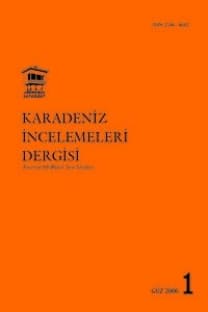TOPLUMSAL MEKÂNIN MERKEZİNİN DEĞİŞİMİ ÜZERİNE BİR DENEME: XIX. YÜZYILIN İKİNCİ YARISINDA TRABZON’DA GELENEKSEL YAŞAMIN HÜKÜMSÜZLEŞMESİ
Karadeniz’in önemli liman kentlerinden biri olan Trabzon, XIX. yüzyılın ikinci yarısından itibaren çok güçlü bir değişim ve dönüşüm geçirmeye başladı. Bu sürecin toplumsal, siyasal, dini, iktisadi ve kültürel yansımaları, kenttin gündelik hayatını derinden etkiledi. Trabzon’un ticarî, siyasi ve diplomatik öneminin artmasıyla paralel gelişen süreç, yüzyılın sonuna doğru şehirdeki klasik yaşamın mekânlarını, içindekilerle birlikte hüküm-süzleştirip değer yitimine uğratırken, gayrimüslimlere ait hayat alanlarını kentin yeni merkezi olarak öne çıkardı. Bu mekân yerli ve yabancılardan oluşan gayrimüslim Trabzon sakinleri etrafında ortaya çıkan bir hayat tarzının kendine yaşam alanı açtığı Gâvur Meydanı idi. Geleneksel yaşamın toplumsal, siyasi ve idari merkez olarak öne çıkardığı alanlar ise Kavak Meydanı ve geleneksel iktisadî-toplumsal yaşamın merkezi olan çarşı-pazardı. Devletin bu sürece tepkisi klasik yaşam alanlarını modernize ederek ayakta tutmak ve yeni ortaya çıkan merkeze eklemlemekti.
Anahtar Kelimeler:
Anahtar Sözcükler: Trabzon, Gâvur Meydanı, Kavak Meydanı, Çarşı-Pazar, Hükümsüzleşme.
AN ESSAY ON THE TRANSFORMATION OF THE CENTER OF A SOCIAL SPACE: THE INVALIDATION OF THE TRADITIONAL LIFE IN TRABZON IN THE SECOND HALF OF THE 19TH CENTURY
Trabzon has been one of the most important ports in the Black Sea Region, and it started to experience a strong change and transformation from the second half of the 19th century. The social, political, religious, economic and cultural reflections of this process have deeply affected the daily life of the city. Parallel to the increase in the commercial, political and diplomatic importance of Trabzon, this process invalidated the spaces of the traditional life in the city with their inhabitants and foregrounded the non-Muslim living spaces as the new center of the city. This space was Gâvur Meydanı, which was the life space of the life-style that emerged around the local and foreign non-Muslim population of Trabzon. Kavak Meydanı was the social, political and administrative center and the shopping districts were the center of the traditional economic-social life, which were all foregrounded by the traditional life. The reaction of the state to this process was to survive the classical living spaces by modernizing them and to join them to the newly emerging center.
Keywords:
Keywords: Trabzon, Gâvur Meydanı, Kavak Meydanı, Shopping Centers, invalidate,
- ISSN: 2146-4642
- Yayın Aralığı: Yılda 2 Sayı
- Başlangıç: 2006
- Yayıncı: Karadeniz İncelemeleri Dergisi
Sayıdaki Diğer Makaleler
PARİS BARIŞ KONFERANSI ABD TUTANAKLARINDA BEYAZ ORDU LİDERLERİ VE BOLŞEVİKLER
NÜFUS CERİDE DEFTERLERİNE GÖRE 19. YÜZYILIN ORTALARINDA GİRESUN’UN NÜFUS YAPISI
İNGİLİZ AMİRALİ SİR ADOLPHUS SLADE’İN TÜRKİYE İZLENİMLERİ
VİSERA (IŞIKLAR) SANTRALİ VE TRABZON ELEKTRİK TÜRK ANONİM ŞİRKETİ’NİN FAALİYETLERİ
GREK KOLONİZASYON DÖNEMİ’NDE KARADENİZ’DE ÖNEMLİ BİR GEÇİM KAYNAĞI: KÖLE TİCARETİ
